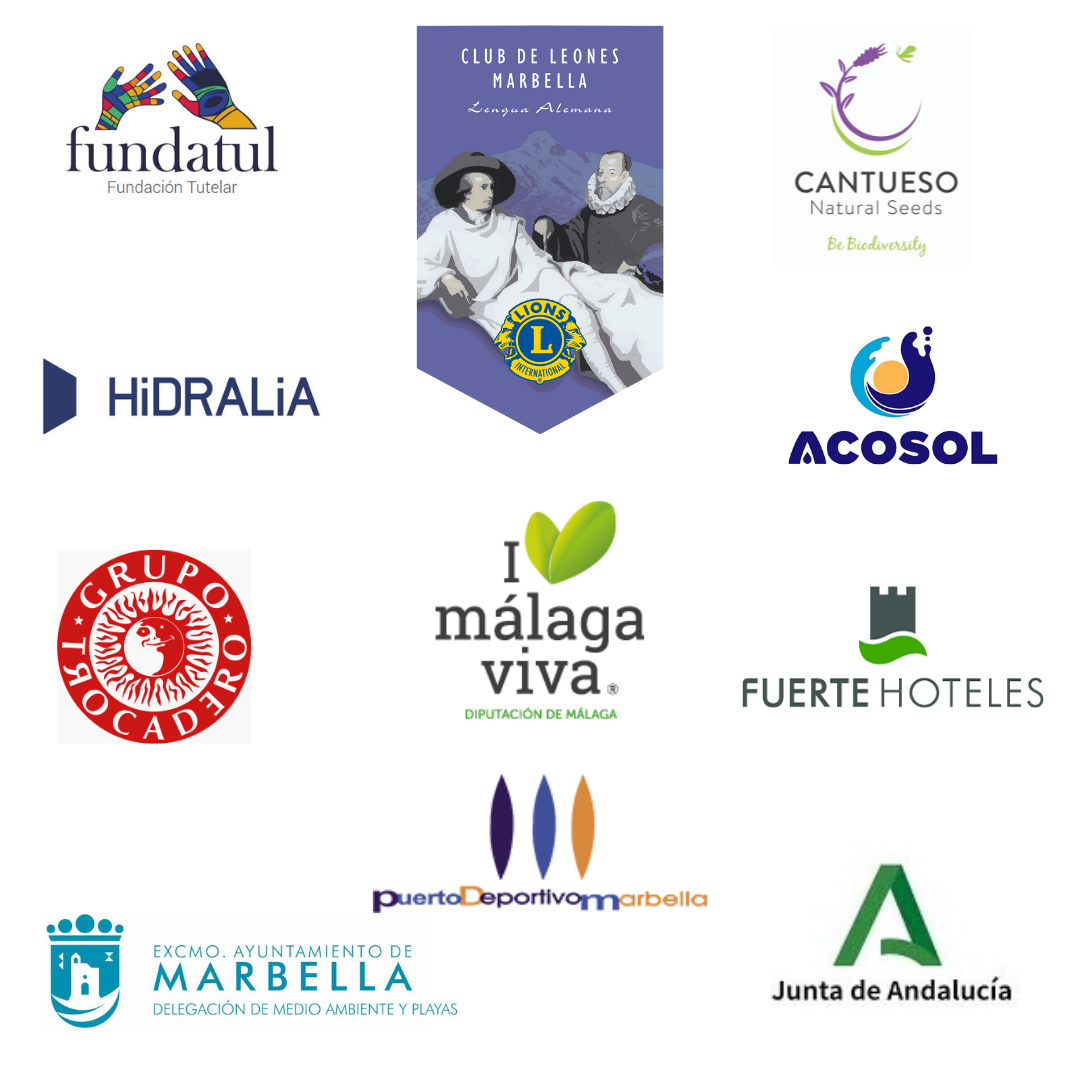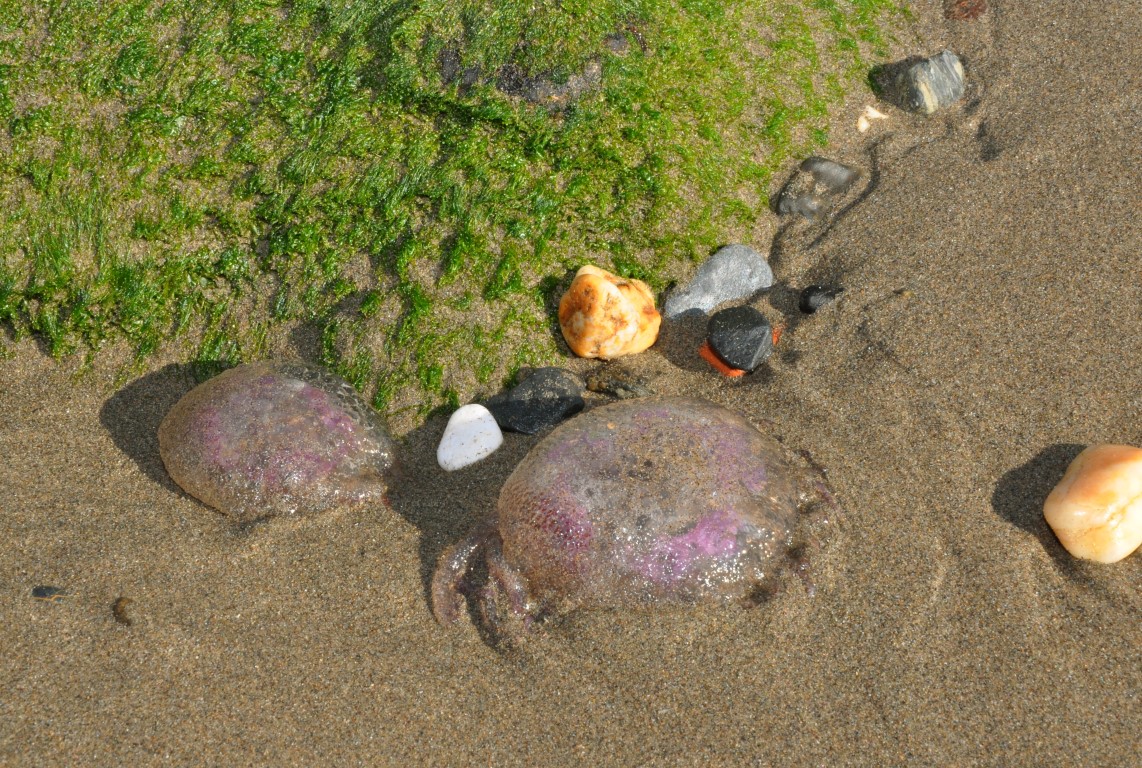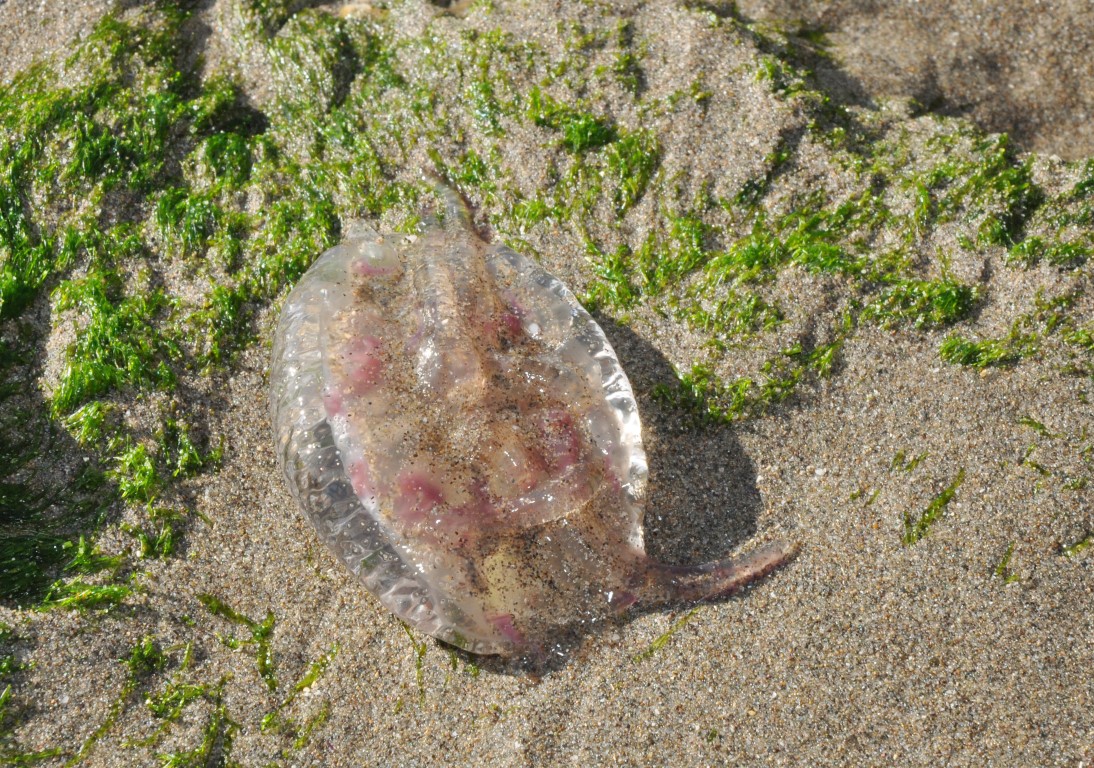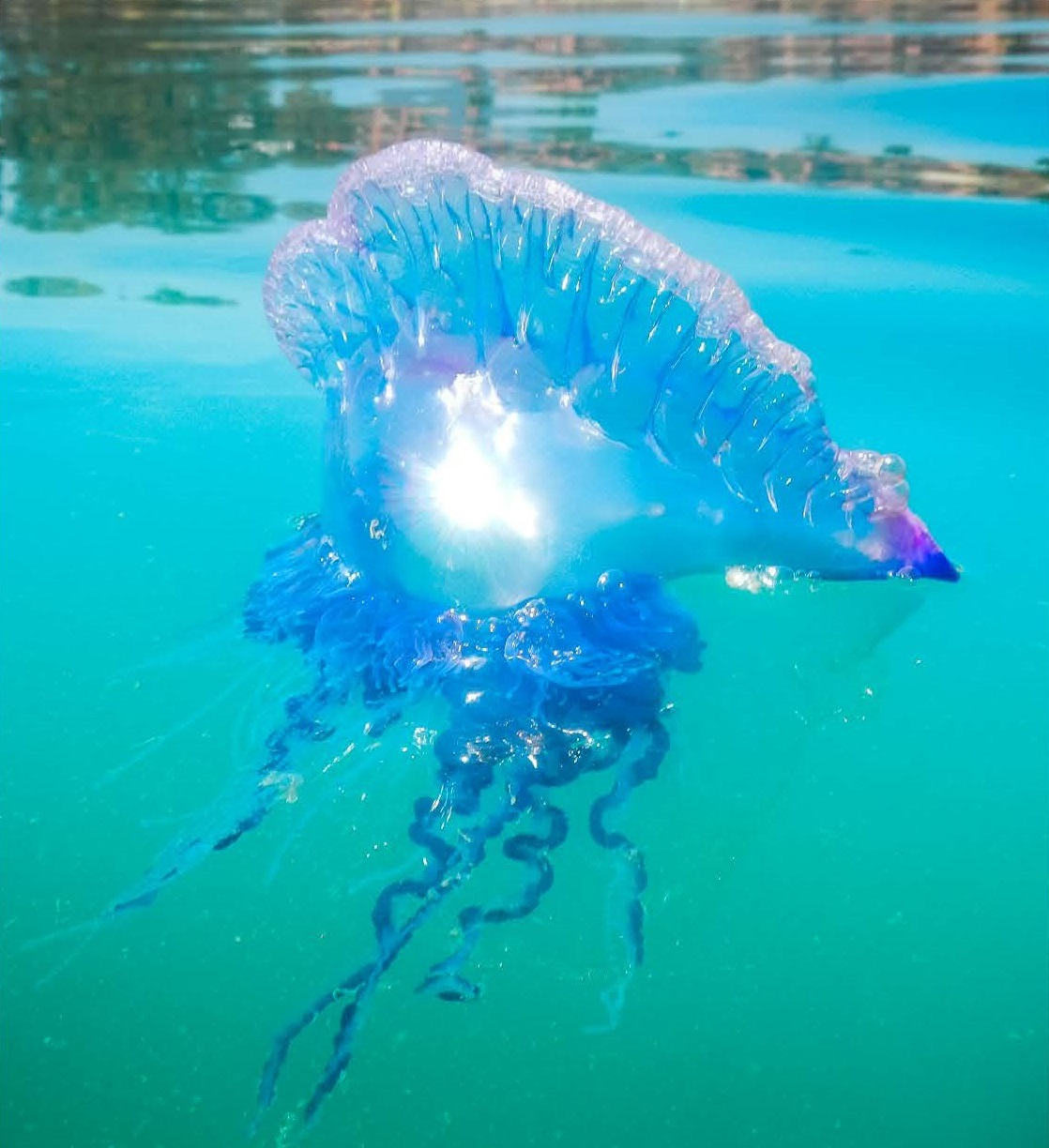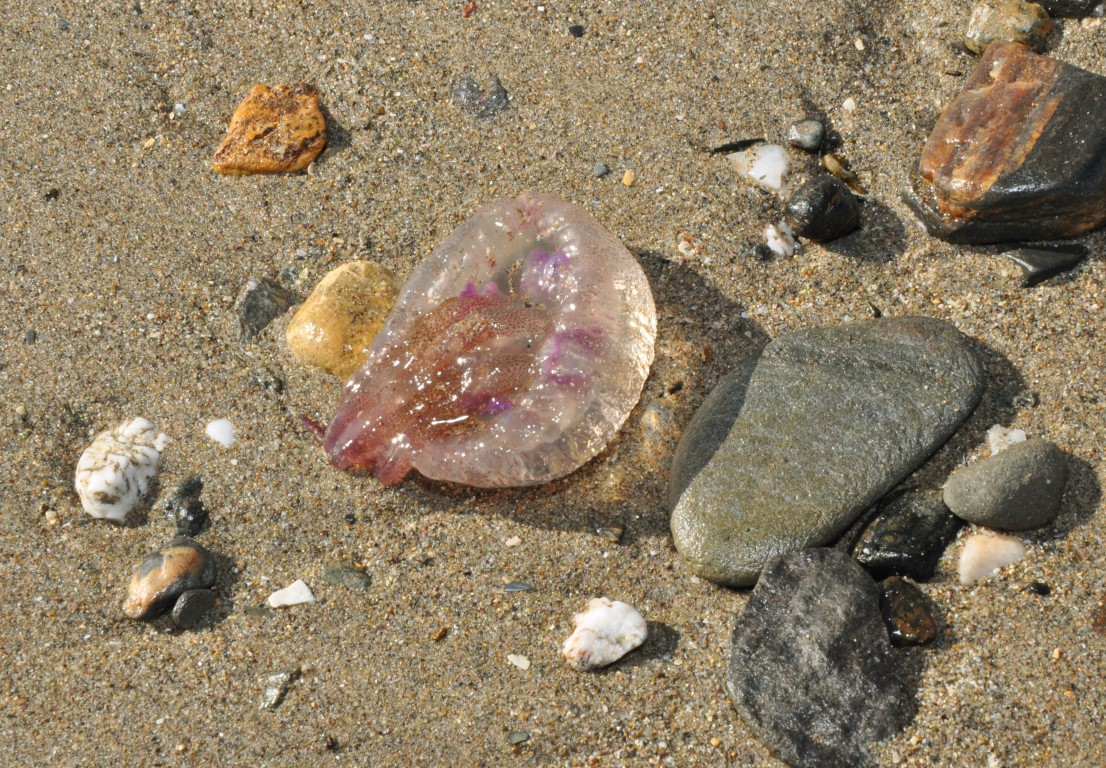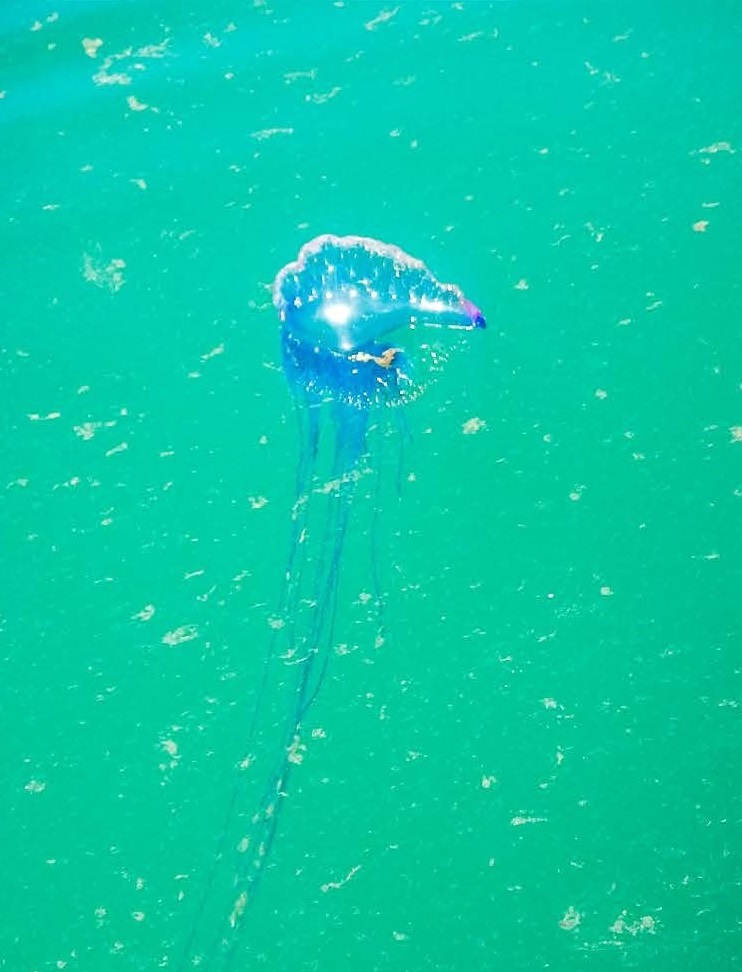SMALL SUMMER TALK WITH THE RTV TELEVISION AND ESTEFANÍA
1st of August 2022 – Jellyish and the marine ecosistems
Jellyfish are part of the marine ecosystem and therefore play a role and are important. However, they are running out of predators and are becoming a problem for other marine species such as anchovies and sardines. Human activity, the warming of the oceans and the emission of pollutants are some of the causes of the proliferation of these animals.
What are jellyfish? It is one of the oldest organisms on our planet. They are planktonic organisms that live suspended in water (generally marine, although there are also some freshwater species). They have a very simple morphology, formed by a bell-shaped structure that houses the stomach and gonads. From this bell, known as an umbrella, the tentacles emerge. They are characterised by having stinging cells, the cnidocysts. These contain a poison that is injected into prey by means of a filament equipped with spines. Just by simple contact with the prey, the cells fire and “sting”.
The Loggerhead Turtle can be found throughout the sea basin, but seems to be more abundant in the western part, from the Alboran Sea to the Balearic Islands. The Green Turtle population is concentrated further east, in the Levantine basin and, more rarely, in the western Mediterranean. The Leatherback is observed in the open sea throughout the basin.
The Loggerhead and the Green Turtles are the only species that breed in the Mediterranean, especially in the Eastern part.
These turtles migrate. In fact, the Loggerhead Turtle makes long journeys to the northwest Atlantic, to Florida, Georgia and Virginia, or to the east, to Cape Verde; then they come back to lay their eggs in the Mediterranean. Years later, they are able to return to their original site. This innate ability of some animals to travel great distances to return to their original nest is called “homing”.
There is a common characteristic concerning these three species that is very worrying: they are all globally threatened according to the IUCN (International Union for Conservation of Nature) and on the Red List.
Loggerhead sea turtle (Caretta caretta): one of the distinguishing features of this sea turtle is its large, strong head, with four scales behind the nose. The shell is longer than wide and oval in shape. They are a dullish brown on the back and yellowish on the underside. They are present in all tropical, subtropical and temperate waters of the world. In their juvenile stages (the most frequent off the coast of Malaga) they have oceanic and migratory behaviour, living far from the coast in their feeding areas. As adults, they tend to inhabit the egg-laying areas in more neritic (shallower, coastal) environments. It is a migratory species and the youngest individuals tend to stay far from their mating areas, to which they only return when they mature and are ready to reproduce. The females can lay several nests in the same season, with 100-150 eggs in each one. They usually rest one or two years before laying again.
We only get to see them when a specimen, dead or alive, ends up stuck on the shore, attracting the attention of everyone on the beach. Seeing them alive is more complicated, since these animals travel alone and are just passing through our coastal areas during their migrations. Turtles have an amazing ability to geo-locate the beach on which they were hatched, and on which they spend only a few minutes before heading to the sea, but many years later, after a journey of thousands of kilometres, they return to this same beach to lay their own eggs.
Unfortunately, together turtle together with the rest of the sea turtles, is threatened on a global scale, and is included on Red List (including the IUCN Red List), National and Andalusian catalogues, as well as being named in international treaties. It will require a big, sustained effort to ensure its survival going forward.
Green Turtle (Chelonia mydas): this is the second most common species in the Mediterranean. It makes its nests mainly on the eastern shores. They have a characteristic green colour. In addition, there is an odd fact that especially characterizes Green Turtles: their diet. When they become adults they change their feeding habits and become herbivorous, feeding exclusively on algae and marine plants such as posidonia. According to the IUCN Red List, the Green Turtle (Chelonia mydas) is in danger of extinction globally.
Leatherback Turtle (Dermochelys coriacea): It does not live exclusively in the Mediterranean, but it can occasionally be found here. It is known for being the largest sea turtle in the world. These huge Mediterranean sea turtles are only sporadic visitors to these waters and their most common habitats are the Atlantic, Indian and Pacific oceans. In fact, it is a highly migratory species travelling several thousand kilometres. A curious fact about this species is that its shell is made of hard skin and not bony plates, as is the case with the other two species we have just named. On the IUCN Red List, the Leatherback Sea Turtle (Dermochelys coriacea) figures as a species in a vulnerable state globally, just as the Loggerhead sea turtle.
Threats to the Turtles in the Mediterranean
Here are the main threats to sea turtles in the Mediterranean:
- A lot of them are caught accidentally by fishermen when trawling. These accidents can cause injuries and lesions as they get entangled in fishing nets. In addition, it was discovered recently that they can suffer from decompression syndrome (the bends), because of stress they suffer when they are subjected to a very sudden change in pressure when the nets are quickly raised to the surface.
- They can also suffer collisions with boats, be they fishing boats or other types, such as cargo transport or recreational boats.
- Then there is, obviously, the problem of marine pollution, especially by plastic. Turtles accidentally eat plastic, as they easily confuse it with their preferred food. For example, they often confuse plastic bags with jellyfish that form part of their usual diet. These intakes can cause intestinal blockages, drowning or malnutrition. In cases where debris gets tangled up in their fins, as is the case with ghost nets, it can even lead to amputations.
- Another noteworthy problem is the destruction of habitat.
- Climate change is also producing a change in the location of nesting areas and in the percentage of females and males hatching out, because the sex of these hatchlings depends on the temperature of the nest. As an example of this, in the Mediterranean specifically, we are beginning to find cases of egg laying in the western area, which is not normal because these animals usually nest on the eastern Mediterranean coast.
How Mediterranean turtles in danger can be helped
Whether in this state, to a lesser degree (vulnerable) or to a greater degree (critically endangered), endangered turtles need the help of people who are willing to make up for this bad situation which is exacerbated by human activity. A lot can be done to help Mediterranean sea turtles.
A direct way to help the turtles of the Mediterranean is to work with institutions dedicated to looking after them:
CEGMA > Andalusian Government in Algeciras, or
CRAM Foundation (Center for the Recovery of Marine Animals)
etc.etc.
Regarding the problem caused by pollution, it is very important to manage our waste properly by recycling, reusing and, above all, reducing the use of products which cause waste in the first place, such as plastic and single-use objects.
We can also help by buying local marine foods, those with sustainable fishing labels, those sold in reliable stores and with well-labelled fish showing respect for minimum sizes and by choosing fish or shellfish caught with selective and sustainable fishing techniques. In this way, we can help regulate the problem of overfishing and fishing techniques that destroy all kinds of species, including these sea turtles.
Since we know that every year turtles turn up to nest more frequently on Mediterranean beaches, the public must be informed of how to act if they find a turtle making a nest or, even if it is found stranded or injured on the beach or even in the sea.
Finally, on the issue of climate change, the massive emissions of CO² that have been recorded in recent years must stop. To do this, we can reduce energy consumption in the home, support public transport, buy local products, buy second-hand, recycled objects, etc.
Nesting on our beaches
Over the night of 3rd to 4th August 2020, something extraordinary happened on the Los Boliches Beach in Fuengirola (Málaga). That night there was a full moon and the Alboran Sea set a record temperature of 26ºC. A Loggerhead sea turtle (Caretta Caretta) on its way through the Alboran Sea decided that this was a good place to lay its eggs. So it came ashore and with the aid of its flippers went a few meters up the beach, dug her nest and laid her eggs. She covered up the 72 eggs with sand and went back down the beach to continue on her way far out to sea.
This fact is very important for the species, because it could mean that it is colonising new beaches; and it appears to be important for the Alboran Sea itself, because the increase in temperature could explain why now, and never before, a Loggerhead sea turtle has nested on the Costa del Sol.
There is no record of previous loggerhead turtle nesting on the beaches of the Alboran Sea (¿?). These turtles, which can come from Cape Verde or Florida, generally lay their eggs in the eastern Mediterranean basin. They do not usually do so in the Alboran Sea due to its proximity to the Strait of Gibraltar. The influence of the Atlantic currents makes the Alboran Sea cooler by several degrees, which is too cool for the turtle.
The eggs were just as far up the beach as the turtle had been able to climb, beside the line of the deckchairs, so the nest was at risk of being flooded. In addition, it is a very busy beach and was not the most suitable area for the safety of the eggs. The nest had to be relocated. It was decided that Cabopino (Marbella), a few kilometres to the west, was ideal due to the granulometry of its sand, because it has high dunes, because of the quality of its groundwater and, above all, because of its temperature. In addition, the Council decided to transfer twelve of the eggs to the Fuengirola Bioparc for supervised incubation.
The move was made on 5th August, and since that day the eggs were under the care of some 220 volunteers recruited by the ProDunas Marbella Association, which has been fighting for decades to maintain the dune environment in Cabopino. The volunteers protected and watched over the sea turtle nest in Cabopino night and day.
Fifty days later, a volunteer spotted that the sand had started to shake. The eggs on the beach and in the Biopark hatched out at the same time, which continues to amaze experts.
Of the total number that hatched out, 49 out of 60 of those on the beach survived, as did 11 out of the 12 in the Biopark, which was counted a resounding success.
The turtles then went to the Algeciras Management Centre, which is supported by the Andalusian Government, where they grew up, getting bigger, hardening their shells and increasing their chances of surviving once they were returned to the sea.
Once they reached the right size, the hatchlings were returned to the sea in the Cabopino area. Some of them carrying geolocators that allow us to see their progress and observe their migration route through the waters of the Mediterranean.
Finally, it must be noted that the Loggerhead sea turtle is still on the IUCN’s Red List of threatened species. That they find new beaches to nest on is good news for the species which usually has problems finding new territories due to its characteristic “philopatria” (returning to lay its eggs in their place of birth). But it could also be another warning sign of climate change: the sea is warming up and this allows the turtles to take a fancy to the Alboran Sea.
Estefanía Espejo González
Bióloga Marina ProDunas Marbella
Do you want to receive our Newsletter?
Do you want to become a member or be our friend of the dunes?
Asociación ProDunas Marbella
The Association works tirelessly for the defence and preservation of the unique ecosystems that survive in the natural sand dune environments in the Province of Málaga; promotes the protection of native flora and small wildlife; promotes recovery, rehabilitation and conservation of interesting biodiversity of sand dunes areas in the municipality of Marbella.
